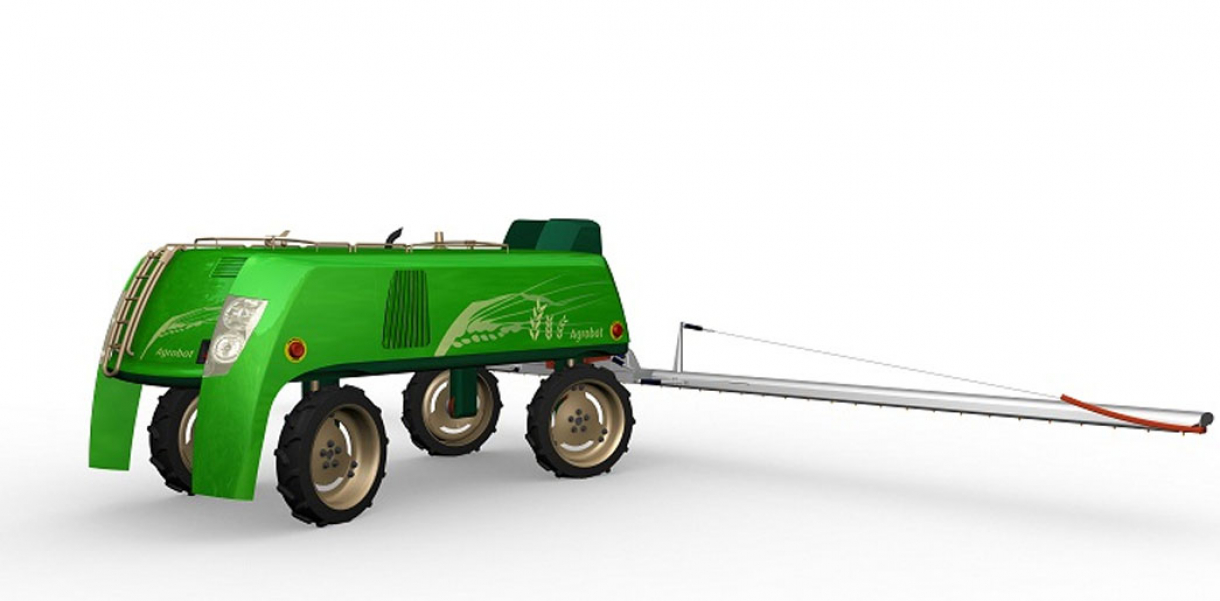Designed to automate spraying, Agrobot is an agriculture robot sprayer. Taking automation trends from the stables and other indoor environments to the fields, Agrobot is the next step in automation of farming. Spraying is often done several times during a crop season as the only field task and is connected with considerable health risk.
Furthermore spraying is carried out during the night hours, when the dew reduces the plants protective layers of oils making plants more sensitive of chemical treatment then at daytime.
Functionality and use of design
Agrobot is programmed for a specific spraying job, initially diagnosed by the farmer. In the field Agrobot does a reconnaissance, making a detailed map of problem areas in the field before beginning the spray treatment. Agrobot navigates by cameras, cross-referenced with a field map and DGPS. Agrobot can be controlled manually with a remote control, which is needed when moving Agrobot from the transporter to the start position in the field.
How did this design improve life?
We realized that ecological agriculture will never overtake conventional agriculture. This means that a significant amount of pesticides, herbicides and fungicides will continue to be used in the agriculture to optimize crops.
Knowing this we realized that the most efficient way to reduce the amount of chemicals (pollution) in agriculture would be to radically address traditional farming methods.
We decided to optimize the spraying process taking in to account the environment, the working environment and the economy of the farmer. Because we realize that modern farming has to be a very cost efficient business.
By automating crop spraying with Agrobot we take much better care of the environments by using state of the art technology.
Agrobot uses a technology developed by the Danish sprayer company Danfoil, which primarily uses air to vaporize a more concentrated solution of chemicals and water. This process creates smaller molecules of the chemical solution resulting in a more efficient coverage on the plant leaves, which means that a smaller doses of chemicals and less water is needed pr hectare.
Furthermore chemicals and water is not mixed before reaching the vaporizer which means zero waste of chemicals. The case with conventional hydraulic spraying techniques is the opposite, here it is practically impossible to calculate the precise amount of chemical solution needed, therefore the farmer mixes an amount of chemicals that he knows is more than sufficient for the spraying job.
The farmer himself naturally conducts the initial diagnosis of problems in the field. But Agrobot can make a more detailed diagnosis by doing a field reconnaissance before starting the treatment. With the help from state-of-the-art plant reorganization systems, a detailed map is generated of where and at what stage the field has been attacked.
With this information Agrobot can make a very precise and specific treatment using absolutely no more chemicals then necessary.
When the farmer has to prepare the Agrobot for spraying he only needs to attend the service zone in the front-end of the Agrobot where he is in no danger of direct contact with the chemical liquids, vapors or settlings.
By automating the spraying process the farmer can get a good nights sleep and he doesn’t have to be exposed to the more or less dangerous chemical fogs whilst spaying jobs are carried out.
Using Agrobot the farmer uses fewer chemicals, which is good for the environment as well as for his economy.
Drawbacks of life improvement
None
Research and need
The research material consists of extensive research on agriculture, from interviews with farmers, to dialogs with different kinds of experts on agriculture, and technical solutions. We have done extensive biological studies to truly understand the spraying treatment, studying weeds, pest and fungus that can attack the crops.
Designed by
Henrik Nørby & Jonathan Ørnstrup - Denmark






